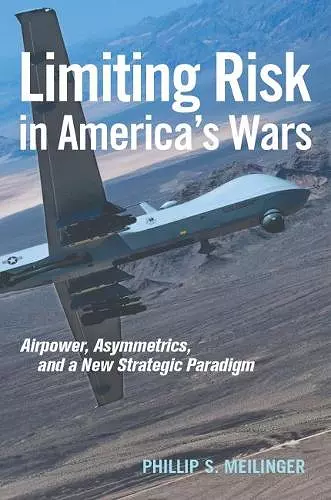Limiting Risk in America's Wars
Airpower, Asymmetrics, and a New Strategic Paradigm
Format:Hardback
Publisher:Naval Institute Press
Published:30th Nov '17
Currently unavailable, our supplier has not provided us a restock date

The United States has the most expensive and seemingly unstoppable military in the world. Yet, since World War II the nation's military success rate has been meager. The Korean War was a draw, while Vietnam, Mogadishu, Afghanistan, and Iraq were clear losses. Successes include Iraq in 1991, the Balkans (Croatia and Kosovo), Panama, the initial takedowns of Afghanistan in 2001 and Iraq in 2003, and Libya. What differentiates the failures from the successes? Failures have been marked by the introduction of large numbers of conventional American ground troops, while successes have been characterized by the use of airpower, special operations forces, robust intelligence and sensor platforms, and the use of indigenous ground troops.
Phillip S. Meilinger's new book advocates strategies that limit risks in war as well as achieve measurable goals. Instead of large numbers of conventional ground troops, the author argues in favor of a focus on asymmetric capabilities--a combination of airpower, special operation forces, intelligence, and indigenous ground troops--to achieve the desired political outcomes.
Meilinger's book is recommended because it addresses critical issues of military strategy and airpower theory…. Meilinger does provide a coherent argument worthy of discussion." --Military Review "[T]his is a book about US strategy, or rather re-thinking US strategy in the context of protecting national interests subject to the usual pressures of representative democracy... [T]he book is easy to read and understand." --From Balloons to Drones "Limiting Risk in America's Wars is an excellent read for military professionals. The author effectively blends ancient and modern warfare history with various military theories to galvanize the argument for an airpower-oriented military strategy. While the author argues for an overreliance on airpower, this book frames the importance of disturbing established ways of warfare to gain asymmetric advantages. By challenging the preconceived paradigm of military capabilities, Meilinger links the concepts of limited risk, indirect approach, and aviation technology to increase America's military effectiveness in future conflicts." --Air and Space Power Journal "The author, in his thoughtful analysis of post-war conflicts, asserts that the nature of war has changed in recent decades…. Recommended." --Aerospace "Philip Meilinger has written a thoughtful and provocative book that warrants close attention from JFQ's readership. The changing character of war suggests it may be worthwhile to use this book as a springboard for once again reexamining airpower's potential contribution to multi-domain operations in the 21st century." --Joint Force Quarterly "Limiting Risk in America's Wars is a provocative study of a thorny problem, full of food for fruitful discussion and thought." --Michigan War Studies Review "This is the sort of book we need to help continue the discussion of how the United States should be engaging in the world. The Air Force is currently developing its next generation bomber which will incorporate the latest in stealth, propulsion, and information technology. At the same time, it is exploring a relatively simple light-attack platform for use in smaller conflicts. These cost money, and the more we discuss what we are trying to accomplish and what systems are required, the better prepared we'll be. This book is a valuable addition to that discussion." --The Free Library "Phillip Meilinger deftly points out the expensive repetitive way that the United States has managed to develop the finest military forces in history, and then proceeded to misuse them shamefully. The author's comprehensive grasp of military strategy, politics, and national characteristics enable him to explain the general failure of U.S. diplomacy across the globe." - Walter J. Boyne, former Director of the National Air and Space Museum "For decades, adherents of the Clausewitzian enshrinement of battle and destruction have directed most American wars--with disastrous and unsustainable consequences. Colonel Meilinger employs a wide range of historical examples to argue persuasively that it is time to rethink basic strategy, capitalize on the asymmetric capabilities of airpower, and undertake wars only when clear and attainable objectives are balanced with smart risk and cost calculations. An important read for the US defense establishment!" - -- Col. John Warden, USAF (Ret.), author of The Air Campaign, co-author of Winning in FastTime, and president of Venturist, Inc. "Dr. Meilinger, one of the leading lights in air power doctrine and theory, focuses on how the United States could use its advantages in air power to achieve national security goals at lower risk and cost. This important work helps illuminate new approaches to the application of US military power in future conflicts." --Christopher J. Bowie, Director of the Northrop Grumman Analysis Center "Phillip Meilinger deftly points out the expensive repetitive way that the United States has managed to develop the finest military forces in history, and then proceeded to misuse them shamefully. The author's comprehensive grasp of military strategy, politics, and national characteristics enable him to explain the general failure of U.S. diplomacy across the globe." --Walter J. Boyne, former Director of the National Air and Space Museum "Phil Meilinger explodes myths and offers new ways to think about the conduct of war. His skillful blending of historical and operational context, proper analysis, and insight into the airpower profession itself makes this timely and in many ways controversial book a must-read for anyone interested in contemporary warfare. It is fascinating, creative and highly enlightening." - Colonel John Andreas Olsen, Royal Norwegian Air Force, author of Airpower Applied
ISBN: 9781682472507
Dimensions: unknown
Weight: 823g
304 pages